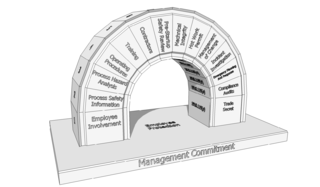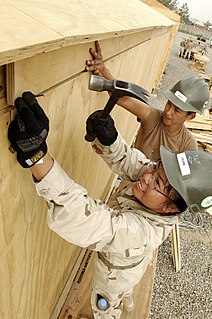
The Occupational Safety and Health Act of 1970 is a US labor law governing the federal law of occupational health and safety in the private sector and federal government in the United States. It was enacted by Congress in 1970 and was signed by President Richard Nixon on December 29, 1970. Its main goal is to ensure that employers provide employees with an environment free from recognized hazards, such as exposure to toxic chemicals, excessive noise levels, mechanical dangers, heat or cold stress, or unsanitary conditions. The Act created the Occupational Safety and Health Administration (OSHA) and the National Institute for Occupational Safety and Health (NIOSH).

The National Institute for Occupational Safety and Health is the United States federal agency responsible for conducting research and making recommendations for the prevention of work-related injury and illness. NIOSH is part of the Centers for Disease Control and Prevention (CDC) within the U.S. Department of Health and Human Services.
Construction work is a hazardous land-based job. Some construction site jobs include: building houses, roads, tree forts, workplaces and repair and maintain infrastructures. This work includes many hazardous task and conditions such as working with height, excavation, noise, dust, power tools and equipment. The most common fatalities are caused by the fatal four: falls, being struck by an object, electrocutions, and being caught in between two objects. Construction work has been increasing in developing and undeveloped countries over the past few years. With an increase in this type of work occupational fatalities have increased. Occupational fatalities are individuals who die while on the job or performing work related tasks. Within the field of construction it is important to have safe construction sites.

Process safety managementsystem is a regulation promulgated by the U.S. Occupational Safety and Health Administration (OSHA). A process is any activity or combination of activities including any use, storage, manufacturing, handling or the on-site movement of highly hazardous chemicals (HHCs) as defined by OSHA and the Environmental Protection Agency.
Hazardous Waste Operations and Emergency Response is a set of guidelines produced and maintained by the Occupational Safety and Health Administration which regulates hazardous waste operations and emergency services in the United States and its territories. With these guidelines, the U.S. government regulates hazardous wastes and dangerous goods from inception to disposal.
The Michigan Occupational Safety and Health Administration (MIOSHA) is a state government agency that regulates workplace safety and health in the U.S. state of Michigan. Michigan OSHA is an agency within the Michigan Department of Licensing and Regulatory Affairs and operates under a formal state-plan agreement with the Occupational Safety and Health Administration (OSHA).
Environment (E), health (H) and safety (S) is a discipline and specialty that studies and implements practical aspects of environmental protection and safety at work. In simple terms it is what organizations must do to make sure that their activities do not cause harm to anyone. Commonly, quality - quality assurance & quality control - is adjoined to form the company division known as HSQE.
"Right to know", in the context of United States workplace and community environmental law, is the legal principle that the individual has the right to know the chemicals to which they may be exposed in their daily living. It is embodied in federal law in the United States as well as in local laws in several states. "Right to Know" laws take two forms: Community Right to Know and Workplace Right to Know. Each grants certain rights to those groups. The "right to know" concept is included in Rachel Carson's book Silent Spring.
Effective safety training is an unofficial phrase used to describe the training materials designed to teach occupational safety and health standards developed by the United States government labor organization, Occupational Safety and Health Administration (OSHA). OSHA has produced many standards and regulations that affect employers and employees in the United States. United States employers have a legal responsibility to educate employees on all workplace safety standards and the hazards that their employees may face while on the job, and providing effective safety training meets that responsibility.

The Health Hazard Evaluation (HHE) program is a workplace health program administered by the National Institute for Occupational Safety and Health (NIOSH). NIOSH developed the HHE program to comply with a mandate in the Occupational Safety and Health Act of 1970 to investigate workplace health hazards reported by employers and employees. According to Section 20(a)(6) of the Act, the Secretary of Health and Human Services is authorized "following a written request by any employer or authorized representative of employees, to determine whether any substance normally found in the place of employment has potentially toxic effects in such concentrations as used or found."

Around the world, nearly 250 million children, about one in every six children, ages 5 through 17, are involved in child labor. Children can be found in almost any economic sector. However, at a global level, most of them work in agriculture (70%). Approximately 2.4 million adolescents aged 16 to 17 years worked in the U.S. in 2006. Official employment statistics are not available for younger adolescents who are also known to work, especially in agricultural settings.
Workplace health surveillance or occupational health surveillance (U.S.) is the ongoing systematic collection, analysis, and dissemination of exposure and health data on groups of workers. The Joint ILO/WHO Committee on Occupational Health at its 12th Session in 1995 defined an occupational health surveillance system as “a system which includes a functional capacity for data collection, analysis and dissemination linked to occupational health programmes”.
An occupational fatality is a death that occurs while a person is at work or performing work related tasks. Occupational fatalities are also commonly called “occupational deaths” or “work-related deaths/fatalities” and can occur in any industry or occupation.

A physical hazard is an agent, factor or circumstance that can cause harm with or without contact. They can be classified as type of occupational hazard or environmental hazard. Physical hazards include ergonomic hazards, radiation, heat and cold stress, vibration hazards, and noise hazards. Engineering controls are often used to mitigate physical hazards.
Accredited Crane Operator Certification OSHA regulation 29 CFR 1926 Subpart CC, released August 9, 2010, requires crane operators involved in construction to be certified by an accredited certification provider by November 10, 2014. An operator is defined as any person operating the equipment. To be accredited, certification providers must be accredited by a nationally recognized accrediting agency, defined as "an organization that, due to its independence and expertise, is widely recognized as competent to accredit testing organizations. Examples of such accrediting agencies include, but are not limited to, the National Commission for Certifying Agencies and the American National Standards Institute." This is the first time certification by an accredited certification provider has been required on a national level, although individual states and cities have required crane operator certification as far back as 2000. The new OSHA standards make the completion of this requirement an important topic of knowledge for the crane and lifting industry.
Contractor Management Automation

People who are driving as part of their work duties are an important road user category. First, workers themselves are at risk of road traffic injury. Contributing factors include fatigue and long work hours, delivery pressures, distractions from mobile phones and other devices, lack of training to operate the assigned vehicle, vehicle defects, use of prescription and non-prescription medications, medical conditions, and poor journey planning. Death, disability, or injury of a family wage earner due to road traffic injury, in addition to causing emotional pain and suffering, creates economic hardship for the injured worker and family members that may persist well beyond the event itself.
Occupational heat stress is the net load to which a worker is exposed from the combined contributions of metabolic heat, environmental factors, and clothing worn which results in an increase in heat storage in the body. Heat stress can result in heat-related illnesses, such as heat stroke, hyperthermia, heat exhaustion, heat cramps or heat rashes. Although heat exhaustion is less severe, hyperthermia is a medical emergency and requires emergency treatment, which if not provided can even lead to death.









